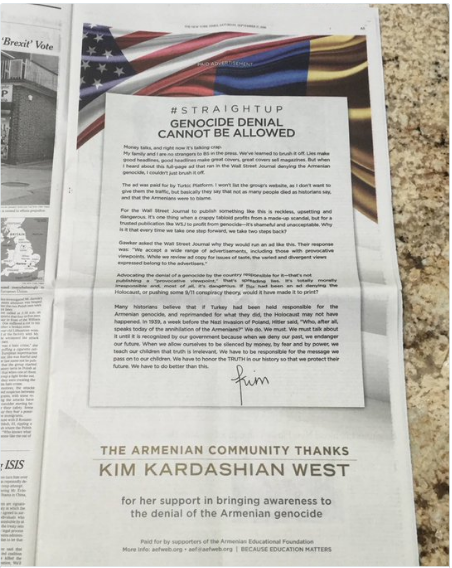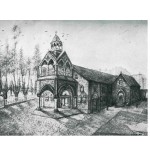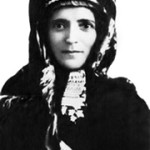The timeliness of the issues involving genocide denial have been vividly illustrated by two unusual full page ads that recently appeared in leading national newspapers, The Wall Street Journal and The New York Times. Television celebrity Kim Kardashian entered the argument with outspoken words posted first on her social media and used later in the second advertisement.
The first ad appeared in The Wall Street Journal last April and was sponsored by “Fact Check America”. It presented what seems to be the official Turkish government position denying there was significant government responsibility in the deaths of an estimated 1.5 million Armenians in 1915. That number represents about one third of Turkey’s Armenian population. A majority of those Armenians lived in the eastern part of Turkey, where massacres of Armenians took place 20 years earlier.
Kim Kardashian responded promptly to the WSJ advertisement with a letter she posted on her social media and later published in an advertisement in The New York Times. In the letter, Kardashian said, “Money talks, and right now it’s talking crap. My family and I are no strangers to BS in the press. We’ve learned to brush it off…” She went on to say “…For The Wall Street Journal to publish something like this…for a trusted publication like the WSJ to profit from genocide – it’s shameful and unacceptable…”
When asked in April about publishing the ad, The Wall Street Journal had replied, “We accept a wide range of advertisements, including those with provocative viewpoints. While we review ad copy for issues of taste, the varied and divergent views expressed belong to the advertisers.”
 In her letter, Kardashian addresses the WSJ‘s position by saying. “Advocating the denial of a genocide by the country responsible for it—that’s not publishing a ‘provocative viewpoint’, that’s spreading lies. It’s totally morally irresponsible, and, most of all, it’s dangerous. If this had been an ad denying the Holocaust, or pushing some 9/11 conspiracy theory, would it have made it to print?” She also wrote, “Many historians believe that if Turkey had been held responsible for the Armenia genocide and reprimanded for what they did, the Holocaust may not have happened. In 1939, a week before the Nazi invasion of Poland, Hitler said, ”Who, after all, speaks today of the annihilation of the Armenians?” We do. We must. We must talk about it until it is recognized by our government, because when we deny our past, we endanger our future…”
In her letter, Kardashian addresses the WSJ‘s position by saying. “Advocating the denial of a genocide by the country responsible for it—that’s not publishing a ‘provocative viewpoint’, that’s spreading lies. It’s totally morally irresponsible, and, most of all, it’s dangerous. If this had been an ad denying the Holocaust, or pushing some 9/11 conspiracy theory, would it have made it to print?” She also wrote, “Many historians believe that if Turkey had been held responsible for the Armenia genocide and reprimanded for what they did, the Holocaust may not have happened. In 1939, a week before the Nazi invasion of Poland, Hitler said, ”Who, after all, speaks today of the annihilation of the Armenians?” We do. We must. We must talk about it until it is recognized by our government, because when we deny our past, we endanger our future…”
Kardashian’s letter became the centerpiece of a full page ad that appeared in The New York Times on September 17. It was sponsored by the Armenian Educational Foundation, which is dedicated to furthering the Armenian heritage through education. The Foundation is located in Glendale, California, home to a large number of Armenian Americans.
She – together with many Armenian American groups and individuals – has advocated unsuccessfully for President Barack Obama to use the word “genocide” when referring to the 1915 massacre of Armenians.
The full text of the ad and the entire letter by Kardashian can be found on her website:
https://www.kimkardashianwest.com/behind-the-scenes/918-kim-kardashian-armenian-genocide
An article about this topic recently appeared in Vanity Fair magazine:
http://www.vanityfair.com/style/2016/09/kim-kardashian-armenian-genocide-new-york-times-ad

